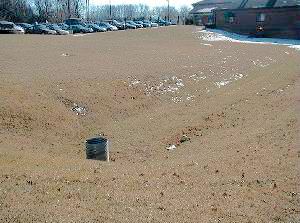 | ||
An infiltration basin (also known as a recharge basin or in some areas, a sump), is a type of best management practice (BMP) that is used to manage stormwater runoff, prevent flooding and downstream erosion, and improve water quality in an adjacent river, stream, lake or bay. It is essentially a shallow artificial pond that is designed to infiltrate stormwater though permeable soils into the groundwater aquifer. Infiltration basins do not release water except by infiltration, evaporation or emergency overflow during flood conditions.
It is distinguished from a detention basin, sometimes called a dry pond, which is designed to discharge to a downstream water body (although it may incidentally infiltrate some of its volume to groundwater); and from a retention basin, which is designed to include a permanent pool of water.
Design Considerations
Infiltration basins must be carefully designed to infiltrate the soil on a given site, at a rate that will not cause flooding. They have been less effective in areas with:
At some sites infiltration basins have worked effectively where the installation also includes an extended detention basin as a pretreatment stage, to remove sediment. The basins may fail where they cannot be frequently maintained, and their use is discouraged in some areas of the United States. For example, they are not recommended for use in the U.S. state of Georgia, which has many areas with high clay soil content, unless soil on the particular site is modified ("engineered soil") during construction, to improve the infiltration characteristics.
